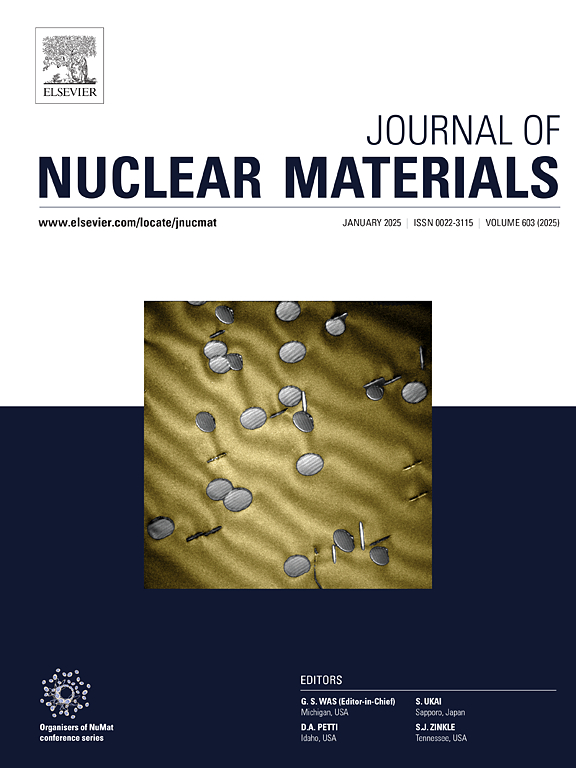Density and surface tension of U1-xZrxO2-y with different oxidation state: measurement and modelling at high temperature for nuclear severe accident applications
IF 3.2
2区 工程技术
Q3 MATERIALS SCIENCE, MULTIDISCIPLINARY
引用次数: 0
Abstract
During a nuclear severe accident, the high temperature reached by the core, above 2000 K, can lead to its melting, forming a material called “corium”. The behaviour of this corium and its thermophysical properties is required to improve knowledge about nuclear severe accidents and develop mitigation tools.
In this work, we focused on two corium thermophysical properties: density and surface tension. The surface tension is highly involved in the jet fragmentation, which influences the power released during a steam explosion, whereas the density is of major importance in the stratification phenomena.
Experimental data were measured using the maximum bubble pressure method. Several compositions of U1-xZrxO2-y corium were investigated at temperatures above 2723 K to estimate the evolution of their thermophysical properties with temperature and composition. SEM-EDS analyses, performed after each test, revealed an alteration of the sample composition during the test at liquid state at high temperature. This allowed to estimate the real composition of the sample when its properties were measured. A complementary approach has been used to model corium surface tension, based on Butler’s equation.
The first results obtained show a decrease of the surface tension when the U/Zr ratio or the Zr oxidation degree of the corium increases. The original coupling between the measured data and the modelling using Butler’s equation promises insightful data over extended temperature and composition domains.
不同氧化态U1-xZrxO2-y的密度和表面张力:用于核严重事故的高温测量和建模
在严重的核事故中,堆芯所达到的2000 K以上的高温会导致其熔化,形成一种叫做“堆芯”的物质。这种堆芯的行为及其热物理性质是提高对核严重事故的认识和开发缓解工具所必需的。在这项工作中,我们重点研究了两个堆芯的热物理性质:密度和表面张力。喷流破碎与表面张力密切相关,它影响蒸汽爆炸过程中释放的能量,而密度在分层现象中起主要作用。实验数据采用最大气泡压力法测量。在2723 K以上的温度下,研究了u1xzrxo2 -y堆芯的几种组成,以估计其热物理性质随温度和组成的演变。每次测试后进行的SEM-EDS分析显示,在高温下的液态测试过程中,样品成分发生了变化。这样可以在测量样品的性质时估计样品的真实成分。一个补充的方法被用来模拟堆芯表面张力,基于巴特勒的方程。结果表明,随着U/Zr比的增大或锆氧化度的增大,表面张力减小。测量数据和使用巴特勒方程的建模之间的原始耦合保证了扩展温度和成分域的深刻数据。
本文章由计算机程序翻译,如有差异,请以英文原文为准。
求助全文
约1分钟内获得全文
求助全文
来源期刊

Journal of Nuclear Materials
工程技术-材料科学:综合
CiteScore
5.70
自引率
25.80%
发文量
601
审稿时长
63 days
期刊介绍:
The Journal of Nuclear Materials publishes high quality papers in materials research for nuclear applications, primarily fission reactors, fusion reactors, and similar environments including radiation areas of charged particle accelerators. Both original research and critical review papers covering experimental, theoretical, and computational aspects of either fundamental or applied nature are welcome.
The breadth of the field is such that a wide range of processes and properties in the field of materials science and engineering is of interest to the readership, spanning atom-scale processes, microstructures, thermodynamics, mechanical properties, physical properties, and corrosion, for example.
Topics covered by JNM
Fission reactor materials, including fuels, cladding, core structures, pressure vessels, coolant interactions with materials, moderator and control components, fission product behavior.
Materials aspects of the entire fuel cycle.
Materials aspects of the actinides and their compounds.
Performance of nuclear waste materials; materials aspects of the immobilization of wastes.
Fusion reactor materials, including first walls, blankets, insulators and magnets.
Neutron and charged particle radiation effects in materials, including defects, transmutations, microstructures, phase changes and macroscopic properties.
Interaction of plasmas, ion beams, electron beams and electromagnetic radiation with materials relevant to nuclear systems.
 求助内容:
求助内容: 应助结果提醒方式:
应助结果提醒方式:


